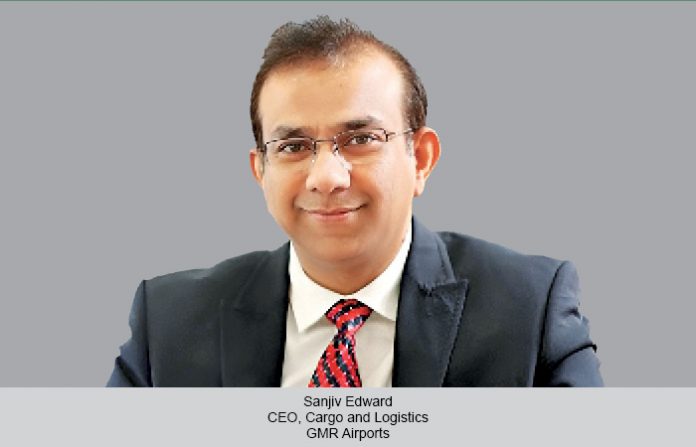Delhi airport is set to transform cargo handling with the Cargo City project, a 50-acre integrated development designed to strengthen India’s position as a global aviation hub. Combining tier I cargo terminals, tier II 3PL facilities, and proposed tier III SEZs, the project aims to streamline ops, reduce logistics costs, and enhance trade competitiveness under initiatives like the NLP and PMGS, says Sanjiv Edward, CEO, Cargo and Logistics, GMR Airports, in an exclusive interview.
Ritika Arora Bhola
Could you share the vision behind the upcoming Cargo City at Delhi airport?
The vision of creating the Cargo City at DIAL emanates from a vision of making Delhi a global airport hub, with the passenger and cargo segments complementing each other. This thought is aligned with the overarching vision of the Union government to create several airport hubs in the country.
What role does Cargo City play in strengthening Delhi’s position as India’s leading air cargo hub?
When we talk of creating a cargo hub, it needs supporting infrastructure of tier I i.e., cargo terminals and tier II i.e., 3PL players with a possible extension to tier III, which would be special economic zones. Delhi Airport has already taken steps to build tier I capacity from 0.3 MMT to 1.8 MMT per annum and tier II capacity from zero to 0.5 million sqft. Now we are working towards developing an additional combined capacity of over 1.5 million sqft over tier II and proposed tier III facilities. This integrated tier I, II and III will then provide infrastructure solutions for the cargo arriving at Delhi airport and help Delhi become a global aviation hub. With this thought we are building the Cargo City.
How does this project align with India’s broader logistics and trade facilitation goals under the NLP and PMGS initiatives?
The project will help bring cargo activities right to the airport, thereby reducing logistics costs. This is in line with the NLP launched by Prime Minister. Such reduced costs will enhance the competitiveness of the Indian products in the global market, giving a boost to our ‘Make In India’ endeavour.
Elaborate on the key infra features and design elements planned for the
Cargo City?
The Cargo City is planned to be a 50-acre integrated development, comprising of general warehouses and express warehouses with double storeyed structures serviced through truck ramps. Development of SEZs is also proposed at the sites. There will be dedicated office areas with options for standalone spaces, plug-and-play spaces, and a separate amenity block to offer services such as Banking, F&B, and dedicated driver dorms, among others. The project is being designed by global consultants and will be world class in terms of features and facilities.
How is the development addressing capacity expansion, automation, and operational efficiency?
By giving end users the opportunity to bring more cargo-related activities right to the airport, we are creating capacity for impact through reduction in logistics cost as well as time, which will result in operational efficiencies. While automation within the individual facilities will depend on the end users’ discretion, most customers intend to develop areas as their regional hubs for this part of the world.
What provisions are being made for temperature-controlled facilities, e-commerce handling, and express cargo ops?
E-commerce is leading the way in Indian trade, and its success depends largely on quick turnarounds. Cargo City will offer the convenience of time to players in this segment. For Express Cargo players, provisions are being made to reduce turnarounds. The project will offer varied asset classes for sub-lease where end users such as temperature-controlled facilities etc., can be created by the Unit Holders.
Do you plan to integrate renewable energy sources, such as solar power, or promote electric handling equipment within the facility?
Yes, the development will use green energy as per the norms of the Delhi International Airport.
In what ways will the facility enhance multimodal connectivity, particularly with road, rail, and freight corridors?
One of the site locations is coming up right next to the Bijwasan Railway line, which will further link to the Western DFC. We are improving its access to the National Highway network via UER II, giving it excellent multimodal connectivity. The other site location is already on the approach road to terminal III and enjoys immediate connectivity to NH-8. Further, a dedicated four-lane road connecting NH-8 to the cargo area in the central zone has been created.
How do you foresee Cargo City backing India’s vision to handle 10 MMT of air cargo by 2030?
As an airport, we have been focusing on developing the cargo infra at Delhi airport for the last several years. In this line, tier I and II infra, including cargo terminals, air cargo logistics centres, and a transhipment excellence centre built specifically to position Delhi airport as a transhipment hub, have already been developed — expansion of tier II and setting up of a proposed tier III facility will be a milestone step towards taking Delhi airport in the right direction, directly supporting India’s Vision to reach 10 MMT by 2030.
Could you provide an update on the current development phase and expected timelines for operational readiness?
Cargo City’s current phase will encompass development of tier II facilities of around 1 million sqft. The development work will start within this quarter, and we can expect to start operations from this Phase 1 in the first quarter of 2027–28 fiscal year.















